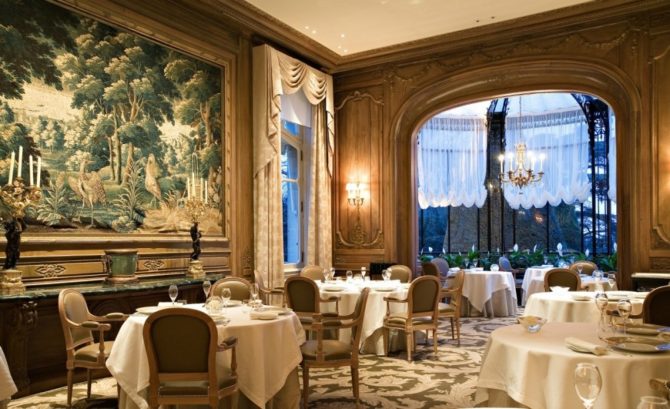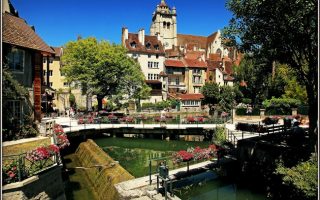Voyage to Reims

Le Domaine Les Crayères was built at the dawn of the 20th century for the Marquis and Marquise de Polignac. Bought in 1979 by the Gardinier family, who turned it into a luxurious hotel-restaurant presided over by chef Gérard Boyer, the imposing mansion grew into one of the most famous landmarks of the Reims region. Most of its 20 sumptuous rooms look out over its 17-acre park and gardens to the city’s great Gothic cathedral and the Basilica of Saint Remi—a refuge of luxe, calme et volupté right in the city center. Boyer’s restaurant soon boasted three Michelin stars, and food-lovers from near and far made the voyage to Reims for his faultless classic cuisine.
After more than 25 years at the helm, Boyer retired in 2003. There followed a few fallow years, with renovation work on the hotel and an excellent new chef who didn’t understand the region or the clientele of Les Crayères.
But the arrival of new director Hervé Fort gave a jolt to a staff that had become slightly demoralized. He increased their number, since, in the interim, the contemporary brasserie Le Jardin had opened in the garden and become a mainstay for local residents. Most importantly, Fort hired a new young chef, Philippe Mille, an assistant to Yannick Alléno at the Hôtel Meurice. Fort describes the chef, the maître d’hôtel, the sommelier and himself as a string quartet: they have to play together, and in the same key. His goal was to revive the legendary spirit of Les Crayères.
Indeed, with Mille at the helm of both the main restaurant Le Parc and the brasserie Le Jardin, the cuisine has rapidly regained its élan. The new Crayères won its first Michelin star in 2011, and—a great rarity—the second star swiftly followed this year. And in the meantime, Mille also was awarded the coveted title of Meilleur Ouvrier de France (MOF).
Behind his calm demeanor, the 37-year-old chef is an incredibly hard worker, driven by a passion he shares with his close-knit team of nearly 40 people. His credo: “I search for the essential, the purest flavor of each product; I try to pare down, and add nothing superfluous.” He aims to give pleasure, and he wants that to be evident in his dishes. “I refuse to cook a la plancha. A fish, for example, I’ll roast it, moisten it with butter, cook it to exactly the right point, and serve the sauce in a sauceboat alongside for an extra touch of gourmandise. We’re in a jewel box here—there must be a relationship between the place and what’s on the plate.” He pauses and adds, “I love this place. For 15 years I dreamed of working here, even as an assistant, and here I am, the chef. I’m a happy man.”
Mille also makes an effort to buy local products whenever possible and to offer some dishes made with modest ingredients—smoked haddock, for example, which he serves in a fish bouillon with saffron potatoes and fennel whipped cream. Other dishes recently on his menu include scallops with foie gras ravioli and artichoke risotto, sole steamed in champagne and, in the autumn game season, stuffed breast of Scottish grouse and hare à la Royale. For dessert, pistachio soufflé, or poached pear in a crisp shell, with a mousseline of crème caramel and pear sorbet.
Mille’s extremely intricate cuisine is nonetheless very simple in taste. On weekends he takes his staff to visit champagne houses or other suppliers—he wants everyone to grow along with the restaurant. His enthusiasm for running the kitchens of Les Crayères shines through right down to what’s on the plate. The front-of-the-house team is part of it all, too—a well choreographed ballet in which everyone seems to enjoy taking part. There’s nothing stuffy about the pinpoint service, just a great professionalism that puts everyone at ease.
Head sommelier Philippe Jamesse, at his post since 2000, has built up his wine list patiently and is rightly proud of his champagnes, with more than 450 references. But that’s only the beginning. Fully half of the wines consumed at Les Crayères, he says, are still wines—bought long in advance and slowly aged in the restaurant’s cellars.
Jamesse may be a soft-spoken and calm man, but he’s also passionate about his profession. He knows how to listen and to propose champagnes, not only to accompany specific dishes, but also to satisfy the tastes of his guests. He discreetly tries to comprehend a client’s budget, and encourages diners to try unknown or rare selections. His love for wine led him to create a line of hand-blown glassware made in Reims by Marne glassmakers. Except for the water goblets, all the glassware on the tables at Les Crayères was designed by Jamesse.
64 blvd Henry Vasnier, Reims, 03.26.24.90.00. www.lescrayeres.com. Rooms €360–€710. Menus €65 (weekday lunch), €110; à la carte €170.
L’Assiette Champenoise
The first view of L’Assiette Champenoise is misleading. Entering a small park in the Reims suburbs, you find a pretty late-19th-century residence. No surprise there. But cross the threshold and you find yourself in a resolutely contemporary environment, but as warm and welcoming as a family home. In fact, chef Arnaud Lallement does work with his family—his mother, sister and wife—all three smiling and efficient.
The story begins in 1986 when Jean-Paul and Colette, Arnaud’s parents, took over the restaurant. In 2000, age 25, Arnaud became head of the kitchen; at 26 he won his first Michelin star and in 2005, his second.
That was the moment when he decided it was time to reinvent the whole establishment. He wanted a modern place in tune with his contemporary cuisine. So little by little the dining rooms were renovated, the kitchen enlarged, the hotel rooms transformed.
Comfort, high-tech and a sense of fun now reign. Electronics are everywhere, for lighting, music and everything else. Bathrooms are spacious. And in the bedrooms, instead of headboards there are wall-sized reproductions of famous paintings: Renoir’s Moulin de la Galette, Ingres and his Grande Odalisque, Caillebotte’s parquet-scraping Raboteurs and, in the largest suite, Géricault’s dramatic Le Radeau de la Méduse. Add a big heated indoor pool, a quiet garden and the attentions of an amiable staff, and the result is pure pleasure.
Lallement works with seasonal products, and half of his short menu changes every month. His talent for bringing out the best flavors equals his technical skills. Among his signature dishes are langoustine royale—truly regal-sized—and fillet of line-caught sea bass seared on one side to a golden-crisp crust, served with girolles in a light ginger sauce. On the menu this fall: a cèpe tartare with crawfish.
When asked if his cooking is influenced by champagne, he laughs. In fact all his cuisine is based on it—he wants all his dishes to pair well with champagne and admits he has lots of experiments yet to try. But although he adores bubbly’s festive character, he also deplores it, because merrymakers are prone to overlook the fact that champagne is often wine of the highest quality, and that a good cuvée can be the match of even the most renowned still wine.
Since he likes to serve champagne throughout the meal, he conspires with longtime head sommelier Frédéric Bouché to organize experimental tasting meals. They might choose recipes that marry well with one single champagne, or serve a different brand with each course, or choose different cuvées of a single brand.
They constantly revise the pairings to complement the ever-changing menus. “Once we’ve come to an agreement the whole team of sommeliers does a tasting,” says Bouché, “so they can explain the pairings to clients.” A tasting can be an unforgettable experience. “We’re not trying to tell clients what they should do, but to spend an enjoyable time together,” says Lallement. “It should be a succession of pleasures.”
Bouché, who was born in Champagne and has been sommelier here for 29 years, knows the chief winemakers of all the champagne houses, and almost every house is on his wine list. He also owns 25 acres of his own vines on the hill of Vertus and sells his grapes to Krug, whose brand has become the house emblem. Nowhere in the world are so many bottles of Krug uncorked—even the champagne served by the glass is the Krug Grande Cuvée.
40 ave Paul Vaillant Couturier, Tinqueux, 03.26.84.64.64. www.assiettechampenoise.com. Rooms €195–€595. Menus €65 (weekday lunch), €138, €158, €198; à la carte €170.
Les Avisés
The champagnes of Anselme Selosse are renowned among wine lovers for their great purity and especially for their rarity. The perfectionist and passionate producer has no choice. His domaine, in Avize, south of Reims near Epernay, has just 19 acres, planted in chardonnay and pinot noir. He has no pinot meunier because his land is not suited for it. Selosse is in the haute couture champagne business.
He spearheaded a wine-making movement highlighting man’s relationship with nature. He was among the first in Champagne to wait long enough to harvest fully ripe grapes, and to insist that everything begins with the vines. For a long time he used biodynamic methods, but he later abandoned them, he says, because he felt prisoner to the system. Today he’s more in line with Japanese sustainable-agriculture guru Masanobu Fukuoka, whose theories are even more insistent on not exploiting or imposing on nature, but rather going with nature’s flow.
Born in Avize, Selosse not only produces unique wines, he’s an atypical and slightly dogmatic winemaker for whom the transmission of knowledge is almost an obsession. That fact helps to explain the nonconformist, yet warm and comfortable, character of the hotel-restaurant he and his wife Corinne have created.
Imagine an 19th-century residence, half-château, half-maison de maître, slightly austere, with an elegant facade, transformed into a bright, contemporary small hotel. The building, next to the Selosse winery, stood empty for some time, and the temptation to make something of it was too great to resist. After a year and a half of renovation, the little bijou opened in 2011, with 10 rooms and a restaurant with just 20 places—and not one more.
At lunch there’s a set menu with starter, main dish and dessert; at dinner there’s one more course. Both menus change every day. The chef, Stéphane Rossillon, rules alone, composing his menus according to the season and the market. His wife Nathalie serves the tables. Et voilà—it’s like having a meal at a friend’s home.
Chef Rossillon is far from a beginner—he started working nearly 30 years ago, and spent the last 13 with three-star chef Anne-Sophie Pic in Valence, who taught him all the workings of la cuisine gastronomique. How did he end up at Les Avisés? A chance meeting, a desire for a different experience. The kitchen was designed entirely to his specifications: one side is open to the dining room, the other has a spectacular view over the vineyard. It’s a courageous undertaking, preparing seven new dishes every day, especially since he works with just one apprentice. But the challenge was taken up with pleasure—the enthusiasm of the Rossillons is apparent, as is that of Corinne Selosse, who’s delighted with the design concept she worked out with interior architect Bruno Borrione.
The rooms, with identical colors, ceilings and bathrooms, all differ in their details: small pieces of furniture, an armchair, an objet d’art, curtains—all provide unique touches in each room. All the rooms have views of the garden or the vine-covered hills. Borrione perfectly grasped the Selosses’ philosophy. They wanted the place to be beautiful but not showy, modern but not cold, luxurious but not extravagant. Everything was designed to save energy and be kind to the planet. The main salon is full of books, deep sofas, vases, paintings and etchings, and a vintage mirror, monumental chandelier and fireplace add to its comfort. The room is large enough for guests to be alone in a cozy corner or to join in conversations with others, as if they were regular guests of friends with good taste in a home they know well. And that’s exactly how it feels.
59 rue de Cramant, Avize, 03.26.57.70.06. www.selosse-lesavises.com. Rooms €230– €380. Menus: lunch €35, dinner €55.
Prices are approximate, per person without wine.
Originally published in the November 2012 issue of France Today
Share to: Facebook Twitter LinkedIn Email
Leave a reply
Your email address will not be published. Required fields are marked *



